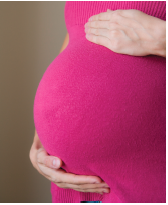In this study, the association between second-trimester maternal serum 25-hydroxyvitamin D concentrations and risk of small for gestational age (SGA) in singleton live births was evaluated. Serum samples at 12-26 weeks of gestation for 25-hydroxyvitamin D were assayed in a sample of participants in a multicenter clinical trial of low-dose aspirin for the prevention of preeclampsia in high-risk women (n=792). The risk of SGA was assessed after adjustment for confounders including maternal prepregnancy obesity, race, treatment allocation, and risk group. The results showed that thirteen percent of neonates were SGA at birth. Mean vitamin D concentrations were lower in women who delivered SGA compared with non-SGA neonates. In adjusted models, vitamin D concentrations of 50-74 nmol/L and 75 nmol/L or greater compared with less than 30 nmol/L were associated with 43% (95% CI 0.33-0.99) and 54% (95% CI 0.24-0.87) reductions in risk of SGA, respectively. Race and maternal obesity each modified this association. White women with vitamin D of 50 nmol/L or greater compared with less than 50 had a 68% reduction in SGA risk and nonobese women with greater than 50 had a 50% reduction in SGA risk. The authors conclude that maternal vitamin D status in the second trimester is associated with risk of SGA. Obstet Gynecol. 2014. PMID: 24463662.









